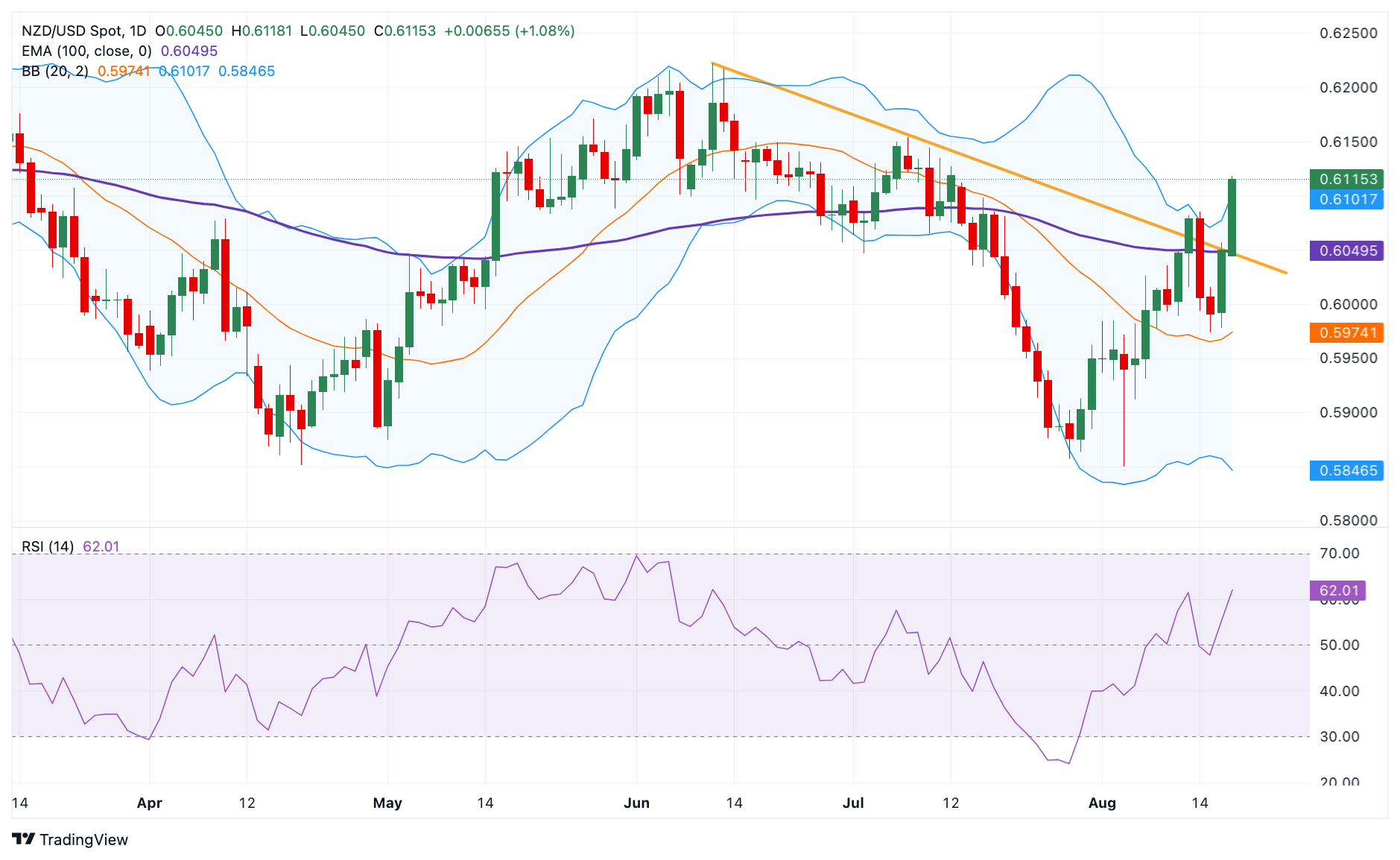New Zealand Dollar extends rally ahead of PBoC rate decision

- The New Zealand Dollar gains momentum in Tuesday’s early Asian session.
- The positive risk sentiment weighs on the US Dollar and lifts NZD/USD.
- Investors await the PBoC rate decision ahead of Fedspeak on Tuesday.
The New Zealand Dollar (NZD) trades in positive territory for the third consecutive day on Tuesday. The risk-on sentiment in global markets and easing geopolitical risks in the Middle East continue to undermine the Greenback. Nonetheless, the dovish remarks from the Reserve Bank of New Zealand (RBNZ) after a surprise rate cut last week might cap the pair’s upside. RBNZ Governor Adrian Orr said on Monday that he is more convinced that inflation has returned to the 1-3% target area, boosting the likelihood of more rate reductions in the future.
Looking ahead, investors will keep an eye on the People’s Bank of China’s (PBoC) Interest Rate Decision, along with the Fed’s Raphael Bostic and Michael Barr speeches on Tuesday. On Friday, New Zealand’s Retail Sales data and Fed Chair Powell’s speech at the Jackson Hole symposium will be in the spotlight.
Daily Digest Market Movers: New Zealand Dollar gathers strength amid broad USD weakness
- New Zealand’s Trade Balance came in at NZD $-9.29B YoY in July versus $-9.5B prior, according to the latest data released by Statistics New Zealand on Tuesday.
- New Zealand’s Exports decreased to $6.15B in July versus $6.17B in June whereas Imports rose to $7.11B compared to $5.45B in previous readings.
- Federal Reserve Bank of Minneapolis President Neel Kashkari said on Monday that it was appropriate to discuss potentially cutting US interest rates in September due to concerns about the weakening labor market, per Reuters.
- Chicago Fed President Austan Goolsbee said on Sunday that the US economy does not show signs of overheating, so Fed policymakers should be cautious about keeping restrictive policy in place longer than necessary.
- The markets are now pricing in a nearly 77% chance of a 25 basis points (bps) Fed rate cut in its September meeting, according to the CME FedWatch Tool.
Technical Analysis: New Zealand Dollar resumes its broader bullish trend
The New Zealand Dollar edges higher on the day. The
New Zealand Dollar FAQs
The New Zealand Dollar (NZD), also known as the Kiwi, is a well-known traded currency among investors. Its value is broadly determined by the health of the New Zealand economy and the country’s central bank policy. Still, there are some unique particularities that also can make NZD move. The performance of the Chinese economy tends to move the Kiwi because China is New Zealand’s biggest trading partner. Bad news for the Chinese economy likely means less New Zealand exports to the country, hitting the economy and thus its currency. Another factor moving NZD is dairy prices as the dairy industry is New Zealand’s main export. High dairy prices boost export income, contributing positively to the economy and thus to the NZD.
The Reserve Bank of New Zealand (RBNZ) aims to achieve and maintain an inflation rate between 1% and 3% over the medium term, with a focus to keep it near the 2% mid-point. To this end, the bank sets an appropriate level of interest rates. When inflation is too high, the RBNZ will increase interest rates to cool the economy, but the move will also make bond yields higher, increasing investors’ appeal to invest in the country and thus boosting NZD. On the contrary, lower interest rates tend to weaken NZD. The so-called rate differential, or how rates in New Zealand are or are expected to be compared to the ones set by the US Federal Reserve, can also play a key role in moving the NZD/USD pair.
Macroeconomic data releases in New Zealand are key to assess the state of the economy and can impact the New Zealand Dollar’s (NZD) valuation. A strong economy, based on high economic growth, low unemployment and high confidence is good for NZD. High economic growth attracts foreign investment and may encourage the Reserve Bank of New Zealand to increase interest rates, if this economic strength comes together with elevated inflation. Conversely, if economic data is weak, NZD is likely to depreciate.
The New Zealand Dollar (NZD) tends to strengthen during risk-on periods, or when investors perceive that broader market risks are low and are optimistic about growth. This tends to lead to a more favorable outlook for commodities and so-called ‘commodity currencies’ such as the Kiwi. Conversely, NZD tends to weaken at times of market turbulence or economic uncertainty as investors tend to sell higher-risk assets and flee to the more-stable safe havens.
